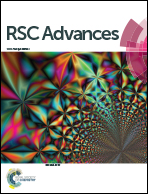Potential therapeutic targets and molecular details of anthocyan-treated inflammatory bowel disease: a systematic bioinformatics analysis of network pharmacology†
Abstract
Anthocyans, containing anthocyanins and anthocyanidins, play a crucial role in preventing and treating inflammatory bowel disease (IBD). Most anthocyanins and their basic elements, namely anthocyanidins have been recognized for the effective treatment of IBD, but the key biomarkers of anthocyan-treated IBD remain unclear. In this study, a bioinformatics analysis based on network pharmacology was performed to demonstrate the core-targets, biological functions, and signaling pathways of most common anthocyanidins that existed in anthocyans to reveal their potential or major mechanisms. The network pharmacology of the multi-target drug molecular design with specific signal nodes was selected, which was used to analyse core targets and complete the bioinformatics analysis of core targets. The network assays indicated 44 common targeted genes, 5 of which were core targets of both six most common anthocyanidins and IBD. These 44 common targets related to major signaling mechanisms of the six most common anthocyanidins in IBD may involve following processes: promotion of intracellular metabolism and proliferation, inhibition of cell necrosis, anti-inflammation and regulation of intestinal epithelial survival mainly via pathways such as, the EGFR tyrosine kinase inhibitor resistance pathway, platelet activation, microRNAs in cancer, arachidonic acid metabolism and the cGMP-PKG signaling pathway. Thus, our findings may provide other molecular details about anthocyans in the treatment of IBD and contribute towards the use of anthocyanidins, which will be meaningful shedding light on the action mechanisms of anthocyanidins in treating IBD.



 Please wait while we load your content...
Please wait while we load your content...